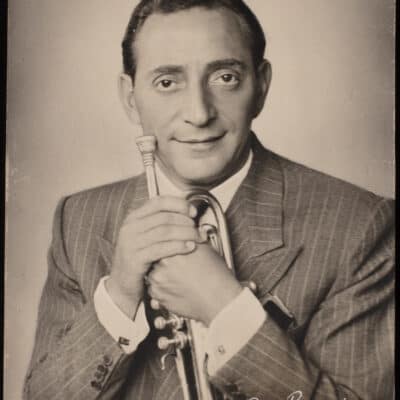During the 1920s and 1930s, the clever dancing melodies of Louis’s Rhythm Five and the jazzy riffs of Louis Bannet and His Adventurers helped to establish Louis Bannet’s reputation as one of the most celebrated trumpeters in all of Europe—the “Dutch Louis Armstrong.”
However, the story of Louis Bannet and of the trumpet that saved his life in Auschwitz-Birkenau begins with a violin. Rotterdam-born Louis Bannet began to play the violin at age seven, his studies supported by the Dutch Jewish communal organization. At age fourteen, he went to a music store to buy a new instrument so he could play jazz. The thirty guilders he had borrowed, however, weren’t enough for the saxophone he craved—but a trumpet was affordable.
Bannet was a natural, and with time he formed and led several groups and helped popularize American jazz in Europe. Through performance and publicity photographs, his face became well known. He even once played before the queen of Holland.Yet all this came to a rapid end when the Germans conquered and then occupied Holland in May 1940. When the “Jews Are Not Permitted” signs began to appear in club and hotel windows, Louis had to quit. He went into hiding with a member of the Dutch underground in June 1942.

Within six months, however, he was recognized in a baker’s shop in the small town of Drimmelen, where he was arrested at gunpoint. On a train with 635 members of the Dutch underground, he was deported to Auschwitz. There, the Dutch interpreter for the Germans recognized him. He was told he might audition for the Men ‘s Orchestra of Birkenau, one of the camp ‘s orchestras and bands. If Louis Bannet’s playing pleased a man named Franz Kopka, the virulently antisemitic Ukrainian kapo of the music detail, his life might be spared-for a while.
His fame, which had previously betrayed him, was giving Louis Bannet, now known as prisoner number 93626, a chance to survive. Bannet described the bitter winter morning of his audition:
Two of my comrades, a trombonist and saxophonist, were with me …. It was terribly cold …. There was a fat, ugly-looking Ukrainian in the room. His name was Kopka. He was the kapo of the music detail … Auschwitz prison’s 42-piece band …. I wondered if any music could touch his soul. If he had a soul. I picked out this trumpet from the assortment of instruments. I never felt less like playing, and I hoped I wouldn’t be first .. .. The trombonist was the first man to play. I had played with him, and I knew he was a good musician. But his music didn’t please the Ukrainian, who waved him out. It wasn’t a fair test. There was a stove in this room, and I got near enough to it so I could warm my fingers and rub them over my lips. My turn came next. I started to play “St. Louis Blues.” American jazz had become very popular in Europe, and this tune was very well known. I kept my eyes on the Ukrainian’s face while I played, and God help me if he didn’t like my music …. It was the most important concert of my life.
Louis Bannet played music at Birkenau for more than two years. During this period, many of the 1. 3 million who walked toward their deaths in the Birkenau gas chambers heard his music on the way. “You couldn’t open your mouth. You couldn’t go near,” he recalled. “A dog is more than you are when you are a number.” Most of Bannet’s forty-one family members were killed by the Nazis at Auschwitz-Birkenau, including his sisters and their children.
He was, however, able to save the life of his older brother, who had weakened and was unable to work. That was a death sentence. Bannet hid his brother in a cart full of refuse that the band hauled away each day, and then sneaked him past the guards to a storeroom, where he smuggled in medicine and brought him back to health. His brother survived.

In November 1944, as the Allies neared, the SS began marching the surviving inmates out of Auschwitz. With his trumpet tied around his waist with a rope, Bannet arrived at the camp at Ohrdruf, Germany. Here, there was no orchestra, only backbreaking manual labor. When he found time to sleep, he wrapped the trumpet in a cloth and used it for his pillow.
Exhausted, Bannet was about to give up, when a friend came to the rescue. He introduced him to a music-loving SS officer, who presented Bannet with a violin with only two strings on it. Here was another test. Thinking fast, Louis played “My Home Is a Star,” a sentimental German melody. The SS man started to cry; he called his wife on the phone and had Bannet play the tune for her. Bannet was shaved and allowed to clean up, and then he played the tune for every SS officer in the camp. Once again, music had given him power—along with extra food for survival.
As the Soviets came nearer, Louis Bannet endured more concentration camps—Sachsenhausen and then Buchenwald, where he was one of 5 1,000 prisoners transported there by the Nazis as the Allies advanced. He was again moved out, this time onto a train, where he spent more than a month with 103 people. Many died each day from typhus. Finally liberated in May 1945, Louis Bannet was one of 17 of the 103 people to survive this final train ride.
He returned to Holland, where he eventually formed a new band and played throughout Belgium, Switzerland, and France. When he finally settled in Canada with his family, Louis Bannet still had his trumpet with him.